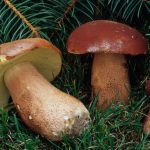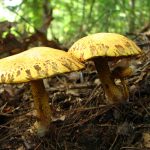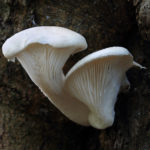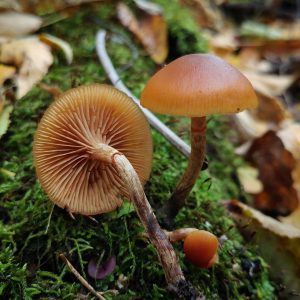Minnesota is one of the few states that actually has a state mushroom—it’s “The Morel” which is actually several different kinds of mushroom. The state also has a wealth of other mushroom species, some edible, some very much not[i]. Studying mushrooms is a fascinating way to get to know a state. Here are a few of Minnesota’s mushrooms, just to whet your appetite.
Just to be clear, we’re not telling you about these delicious wild mushrooms so you can go out and start foraging tomorrow. Foraging for the dinner table is for experts only, for a variety of reasons. We’re telling you about them so you’ll want to become an expert.
If you do indeed go Mushroom Hunting make sure you have the proper tools, take a quality knife with you and a basket/bag for your haul!
This list is not meant to be used as a replacement for a field guide, spore prints, an identification app or an in person guide.
Our Recommended Field Guides for Minnesota
COVER | TITLE | Header | ||
|---|---|---|---|---|
OUR #1 RATED | ||||
Edible Mushrooms in Minnesota
Wild Mushroom (Agaricus sp.)




You know that cultivated species variously sold as WhiteButton, Crimini, or Portobello? Each name specifies an age and variety, but what’s the species called? Turns out, it’s common name is “mushroom.” All other fungal fruiting bodies are called that strictly by analogy, the same way we might refer to a lion as a “cat.” But there are several wild species that are closely related to, and closely resemble, the real mushroom. These are properly called wild mushrooms. Minnesota has half a dozen of them. Some are poisonous. At least one is so poorly understood by science that we can’t say what it is. But at least two make good eating; the Meadow Mushroom (Agaricus campestris)[ii] and the Pavement Mushroom (Agaricus bitorquis)[iii]. The former is variable in color and the flesh sometimes turns pinkish when cut. The latter is always white.
Please note either could be confused with dangerously toxic species if certain details are missed.
Boletes










The boletes are those fungal fruiting bodies that have an umbrella-like shape but have pores instead of gills. They were once all classified in the same genus, Boletus, but most have since been reassigned. Many are edible, and some are choice. Some are toxic or unpalatable. Minnesota has a great many boletes, but only a few are good to eat.
The Noble Bolete (Boletus nobilis) may be in the process of getting a new name[iv], but it is good to eat[v] and some consider it choice. The Almost-Bluing Bolete (Boletus subcaerulescens) is a choice edible that sometimes bruises blue but not always[vi]. The Chicken Fat Mushroom (Suillus americanus)[vii] is yellow and slimy and can fruit abundantly. It’s good when cooked the right way, but if handled raw it can sometimes cause a rash. Painted Suillus (Suillus spraguei)[viii] and Slippery White Bolete (Suillus placidus)[ix] are both edible but not very good. Butterball (Suillus weaverae) is reportedly edible, but confusion the definition of this species makes researching it difficult[x].
Morels (Morchella sp.)




The morels are a genus of famously delicious and oddly-shaped mushrooms. Curiously, though almost universally proclaimed an obviously excellent mushroom for the table, morels do sometimes make people ill (even when properly cooked). The other odd thing about morels is that even though it’s usually obvious whether something is a morel (there are so-called false morels, but telling the two groups apart is not difficult), it’s sometimes impossible to be sure which morel you’ve got. Some species look so much like each other that they share a common name, while others are so variable that one species can have multiple common names. It doesn’t help that many people seem not to even realize there are multiple morel species.
Minnesota is listed as having two morel species, the Black Morel (Morchella elata) and the Yellow Morel (Morchella esculenta).
Puffballs




Puffballs are a group that are mostly not related to each other but are all more or less ball-shaped (some do have short, thick stalks and are thus pear-shaped) and all carry their spores internally. When the spores mature, the ball either develops a pore to release the spores or simply splits open. While there are poisonous puffballs (usually called Earthballs) these are much more firm than edible puffballs and have other differences that make confusion unlikely provided one knows what to look for. If harvesting puffballs for the table, it is critical to slice the ball vertically to make sure the interior is white and homogeneous. Once the spores start to change color and mature, puffballs are no longer edible. And any trace of internal structure could indicate that the ball is actually the “egg” stage of another mushroom—and some of these others, notably the destroying angel, could kill anybody who eats one.
Most of Minnesota’s puffballs are members of the Lycoperdon genus—at least eight of them. These are small to mid-sized, often pear-shaped. There are at least two members of the genus, Calvatia, though, and these are much bigger. The Purple-Spored Puffball (Calvatia cyathiformis)[xi] can be up to the size of a soccer ball and is somewhat variable in shape. Its purple spores (at maturity) are indeed unusual among puffballs—most have brown. The Giant Puffball (Calvatia gigantea) can get basketball size, or sometimes even larger. Its size is its most distinctive feature, though it has a similarly-large western relative with rougher skin.
Puffballs have a curious texture that not everybody really likes, plus the high protein content (basically you’re eating a solid mass of immature spores) means they go bad as quickly as meat does once picked—and the larger ones seldom fit in a refrigerator. One solution is to slice and then dry the puffballs and then powder the result. The puff powder will then keep a long time if stored properly and can be used to thicken soups[xii].
Inky Caps






The inky caps are another not-closely-related group united by their odd way of handling sore release; as the spores mature, the mushroom turns to black, spore-filled goo and drips away. Before that happens, these mushrooms are edible, though picking them speeds up gooification, so you’ve got to cook them right away. The goo itself is edible and makes an interesting food dye, but a half-gooed mushroom is not generally palatable. Some inky caps have a substance that works just like the medication, Antabuse—as long as the stuff is in your system, drinking alcohol will make you very sick. Many people consider a meal of inky caps worth some temporary sobriety.
Minnesota has at least three species in the group, including Shaggy Mane (Coprinus comatus), which does not interfere with alcohol[xiii] and is favored as food[xiv] and Mica Inky Cap (Coprinellus micaceus)[xv], which may interfere with alcohol[xvi] and it is rather bland. The Hare’s Foot Inky Cap (Coprinopsis lagopus)[xvii] is not edible, though it’s not known whether it’s poisonous. Mostly it’s just very small—weirdly pretty, though. These have close relatives in the state whose status as inky caps is debatable as they do not turn to ink.
Velvet Foot (Flammulina velutipes)


Velvet foot[xviii] is one of a large group of LBMs—it’s not a technical term, it just means “little brown mushrooms.” It’s not that all these species took identical, it’s that beginners and experts in a hurry can easily miss the subtle distinctions between species. And that’s a problem, because while velvet foot and a few other LBMs are edible, some LBMs are psychoactive (not a fun thing if you weren’t expecting it) or, worse, deadly. They can also grow in clumps of edible and deadly mushrooms mixed together. Check every single mushroom before eating. Every one!
Velvet foot’s other claim to fame is that it’s widely cultivated and sold under the name enoki or enokitake. Yes, it’s true, enoki mushrooms look completely different, less like little red-brown umbrellas and more like white beansprouts. That’s because the cultivated version is deliberately deformed by being forced to fruit in conditions of no light or fresh air. Either form is good for the table.
Honey Mushroom (Armillaria sp.)


Honey mushrooms are named for their color, not their taste, but they are well-known, popular edibles. Occasionally, they also poison people. No one knows why, yet, meaning there’s no way to know whether you’re likely to get poisoned if you eat it. Some experts no longer recommend eating these mushrooms, but problems do seem to be very rare.
More of a problem is that these, too, are LBMs, with all the risk of misidentification that implies.
It’s not entirely clear how many species Minnesota has, since-honey mushroom taxonomy is still very much in flux.
Oyster Mushroom (Pleurotus sp.)










The oysters are a group of edible mushrooms (they do have some inedible look-alikes) that are widely cultivated but seldom sold as they don’t keep well. Generally, they have a soft, light texture and a mild but complex flavor. They do not taste like oysters at all, but some species look a little oyster-like. Many are asymmetrical, attached at their side by a short stem or none at all to the wood they grew from. Some are more parasol-shaped, but with a thick stem and a small cap. The gills run partway down the cap, if there is one.
Minnesota has at least five species.
The original oyster mushroom, the one people mean if they say “oyster mushroom” and don’t specify which one, is Pleurotus ostreatus. Two other, very nearly identical, species have bee split off from the American population, the Aspen Oyster (P. populinus) and the Summer Oyster (P. pulmonarius). So Minnesota has three oystery-oyster species[xix]. The state is also home to the Veiled Oyster (P. dryinus), which, as the name implies, is the only oyster to have a partial veil and thus, at maturity, a ring on the stem[xx]. The Golden Oyster (P. citrinopileatus)[xxi] is a subtropical species that has escaped from cultivation in several areas, including parts of Minnesota. It’s a lovely yellow color, at least when young, and since it’s not supposed to be here anyway, it’s probably OK to harvest as much as possible.
Poisonous Mushrooms in Minnesota
Want a rule of thumb to figure out which mushrooms might be poisonous? Always correctly identify mushrooms before eating them. There, that’s your rule. Try to follow any other rules, the kind that seem to allow you to assess the danger of a mushroom you can’t identify, and you are likely to get killed. All such rules have exceptions, mushrooms that look very different from all other poisonous species and are still poisonous anyway.
Also, please be aware that there are a lot of species that are poisonous sometimes but not others and are therefore the subject of great debate among mycophiles as to where to draw the line. You’ll have to make your own judgment, but please make it as informed a judgment as possible. We like having living readers!
This list is not exhaustive.
Amanita sp.




The Amanitas are a group of mostly very handsome mushrooms. Some are safe to eat. Some will make an eater very, very sick. Some of them are the deadliest mushroom species in the world, and are all the more dangerous because the effects of the poison in question are difficult to diagnose. Although these mushrooms are mostly very distinctive-looking, it is still possible for even an experienced forager to me a mistake simply by neglecting to do a thorough identification job. Agarics, inky-caps, shaggy parasols and others have all been confused with deadly Amanitas through either ignorance or simple inattention. No one is ever too smart or too knowledgeable to make a dangerous mistake.
With that dire warning…. Minnesota has a huge number of Amanita species running the continuum from safe to very much not so. The scariest are undoubtedly the Destroying Angel (Amanita bisporigera) and the Death Cap (A. phalloides). The name “destroying angel” also applies to several other similar and closely-related species, but this one is Minnesota’s. It is white or whitish. The death cap is not native to the state but has been accidentally introduced. It is white with a pale greenish-brown cap. Both are aptly-named. Three subspecies of False Death Cap (A. citrina) are close to the other end of the spectrum, for although they contain the same toxin as the deadlies, it is in such small quantities that they are probably safe to eat—not that any rational person is likely to try given that they are destroying-angel look-alikes. There are safer Amanitas for the hungry, easier to identify, though some experts recommend avoiding the whole genus.
Also notable are Fly Agaric (A. muscaria) and Panther Cap (A. pantherina), both of which are psychoactive–but their “active ingredient” is not psilocybin but something a good deal less safe, plus there are other toxins present besides. Fatalities are rare, but eaters do get very, very sick. Through careful processing it is possible to reduce the toxin level to the point that these mushrooms can be used, but a mistake in processing could be very dangerous. There is a reason most psychonauts prefer psilocybes.
Deadly Galerina (Galerina marginata)


Deadly galerina is one of several other, mostly unrelated, species that contain the same toxin as the most dangerous Amanitas—and in quantities that can kill adult humans. Worse, it is an LBM that sometimes grown mixed in with other LBMs. It is the primary reason why nobody but an expert should ever harvest an LBM.
False Parasol (Chlorophyllum molybdites)
False parasol is the most toxic of the shaggy-parasol group, all of which can be safely eaten sometimes while at other times making eaters sick. It’s just that this one proves poisonous more often than not. It’s not usually deadly, but is highly unpleasant. And not only does this species look like shaggy parasol, it can also be mistaken for some of the Agarics and some of the ink-caps (and the deadly Amanitas). It makes a lot of people sick through mistaken identity.
False Morels


The false morels are a group of mushrooms with wrinkled caps that look vaguely like the pitted caps of the morels. Some writers include only the Gyromitras in the group, but others also include some Verpas and some Helvellas, too. All three have representatives in Minnesota. It’s possible to mistake these mushrooms for morels, but most people who eat them don’t do so because of mistaken identity. They eat false morels on purpose.
The thing is that there is a great deal of debate over whether false morels should be counted as toxic. No one doubts that they must be prepared properly and that they sometimes make people sick even then—but the same is true of many edibles in good standing, including morels. Many people eat false morels for years without trouble. We include them in the poisonous-mushroom section primarily because one of their toxins can accumulate in the body, causing no symptoms for years until suddenly poisoning becomes serious—a situation that makes judging the safety of the meal difficult at best.
There are a great many false morel species in Minnesota. The best-known and most controversial is probably Gyromitra esculenta.
Yellow Stainer (Agaricus xanthodermus)


The yellow stainer is the poisonous one of Minnesota’s so-called true mushrooms[xxii]. It’s not deadly, merely unpleasant. It bruises a very distinctive yellow, but several similar species also bruise yellow, just generally not the same shade. Not everything that looks like a cultivated mushroom is safe.
Magic Mushrooms in Minnesota
Most “magic” mushrooms contain psilocybin—and all on our list here do. There are other psychoactive substances that appear in fungi, but they are mostly riskier to use. Psilocybin is not risk-free, but as methods of altering the mind go, it is relatively safe.
What’s not safe is possessing—or, worse, growing—these mushrooms in Minnesota, as psilocybin counts as an illegal drug in both state and Federal law[xxiii]. Please take this seriously.
There are several species that contain psilocybin and grow wild in the state, though the well-known genus, Psilocybe is not represented[xxiv]. Besides the legal issue, these mushrooms are, to a greater or lesser extent, look-alikes of the Deadly Galerina. Please take that seriously, too.
Gymnopilus sp.
Minnesota has several species in this genus, though it’s difficult to say which, as Gymnopilus taxonomy is still a bit unclear. There isn’t a lot of published information on what using gyms is like—they’re not as popular as the Psilocybes or pans—but reportedly the high is qualitatively a bit different. Users seem to like the experience.
Banded Mottlegill (Panaeolus cinctulus)


The Banded Mottlegill is among the most widespread of the mottlegills or pans, so called because their spores mature and darken in uneven patches. Not all mottlegills are psychoactive, but some are, and some are extremely potent, with a high reportedly very like that of the Psilocybes but stronger. The banded mottlegill is more low- to mid-range in terms of potency.
Our Recommended Field Guides for Minnesota
COVER | TITLE | Header | ||
|---|---|---|---|---|
OUR #1 RATED | ||||
References:
[i] (n.d.). Minnesota Mushrooms. MinnesotaSeasons
[ii] (n.d.). Agaricus campestris L.–Field Mushroom. First Nature
[iii] Wood, M., Stevens, F. (n.d.). California Fungi—Agaricus bitorquis. The Fungi of California
[iv] (n.d.). Boletus nobilis. The Bolete Filter
[v] (n.d.). Boletus nobilis Peck. Mycology Collection Portal
[vi] (n.d.). Boletus subcaerulescens (“Almost Bluing King Bolette”). The Bolete Filter
[vii] Volk, T. (2004). Suillus americanus, the Chicken-Fat Mushroom. Tom’s Fungi
[viii] (n.d.). Painted Suillus (Suillus spraguei). MinnesotaSeasons
[ix] (n.d.). Suillus placidus (Bonord.) Singer—Slippery White Bolete. First Nature
[x] Kuo, M. (2022). Suillus weaverae. MushroomExpert
[xi] Wood, M., Stevens, F. (n.d.). California Fungi—Calvatia cyathiformis f. fragilis. The Fungi of California.
[xii] Bergo, A. (n.d.). Puffball Mushrooms. Forager/Chef
[xiii] (n.d.). The Inky Cap Mushroom: Can You Safely Eat and Consume Alcohol? Mushroom Huntress
[xiv] (n.d.). Coprinus comatus (O.F. Müll.) Pers.—Shaggy Inkcap. First Nature
[xv] (n.d.). Coprinellus micaceus (Bull.) Vilgalys, Hopple & Jacq. Johnson—Glistening Inkcap. First Nature
[xvi] Clarke, D., Crews, C. (2014). Hazards and Diseases. Encyclopedia of Food Safety
[xvii] (n.d.). Coprinopsis lagopus var. lagopus (Fr.) Redhead. Vilgalys & Moncalvo. Johnson & Hopple—Hare’s-foot Inkcap. First Nature
[xviii] Volk, T. (1997). This Month’s Fungus Is Flammulina velutipes, also Known as the Winter Mushroom, Velvet Stem, Velvet Foot, Enoki, Enokitake. Tom’s Fungi
[xix] Volk, T. (1998). Tom Volk’s Fungus of the Month for October 1998. Tom’s Fungi
[xx] Emberger, G. (2008). Pleurotus dryinus. Messiah University
[xxi] Emberger, G. (2008). Pleurotus citrinopileatus. Messiah University
[xxii] (n.d.). Agaricus xanthodermus Genevs.—Yellow Stainer. First Nature
[xxiii] (n.d.). Psilocybin in Minnesota: Magic Mushrooms in MN, USA Legal Guide. Psilocybin
[xxiv] (n.d.). Which Psilocybin Mushroom Grow Wild in My Area? Shroomery





